
In geology and mineralogy, a mineral or mineral species is, broadly speaking, a solid substance with a fairly well-defined chemical composition and a specific crystal structure that occurs naturally in pure form.

Sphalerite is a sulfide mineral with the chemical formula (Zn,Fe)S. It is the most important ore of zinc. Sphalerite is found in a variety of deposit types, but it is primarily in sedimentary exhalative, Mississippi-Valley type, and volcanogenic massive sulfide deposits. It is found in association with galena, chalcopyrite, pyrite, calcite, dolomite, quartz, rhodochrosite, and fluorite.

Brookite is the orthorhombic variant of titanium dioxide (TiO2), which occurs in four known natural polymorphic forms (minerals with the same composition but different structure). The other three of these forms are akaogiite (monoclinic), anatase (tetragonal) and rutile (tetragonal). Brookite is rare compared to anatase and rutile and, like these forms, it exhibits photocatalytic activity. Brookite also has a larger cell volume than either anatase or rutile, with 8 TiO2 groups per unit cell, compared with 4 for anatase and 2 for rutile. Iron (Fe), tantalum (Ta) and niobium (Nb) are common impurities in brookite.
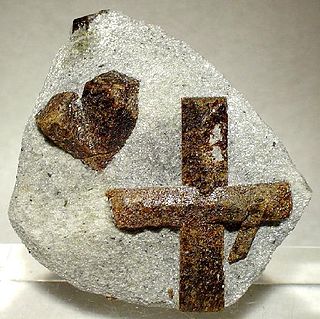
Staurolite is a reddish brown to black, mostly opaque, nesosilicate mineral with a white streak. It crystallizes in the monoclinic crystal system, has a Mohs hardness of 7 to 7.5 and the chemical formula: Fe2+2Al9O6(SiO4)4(O,OH)2. Magnesium, zinc and manganese substitute in the iron site and trivalent iron can substitute for aluminium.

Epidote is a calcium aluminium iron sorosilicate mineral.
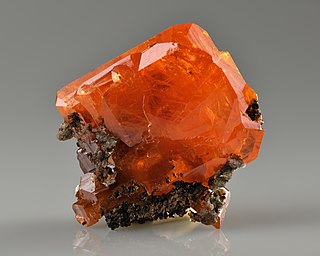
Wulfenite is a lead molybdate mineral with the formula PbMoO4. It can be most often found as thin tabular crystals with a bright orange-red to yellow-orange color, sometimes brown, although the color can be highly variable. In its yellow form it is sometimes called "yellow lead ore".
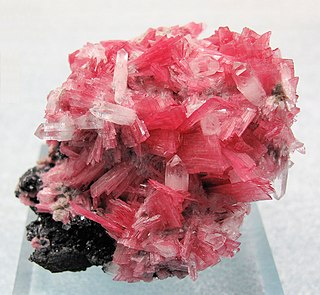
Rhodonite is a manganese inosilicate, with the formula (Mn, Fe, Mg, Ca)SiO3, and member of the pyroxenoid group of minerals, crystallizing in the triclinic system. It commonly occurs as cleavable to compact masses with a rose-red color (its name comes from Ancient Greek ῥόδον (rhódon) 'rose'), often tending to brown due to surface oxidation. The rose-red hue is caused by the manganese cation (Mn2+).
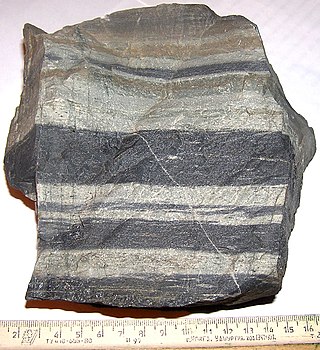
Hornfels is the group name for a set of contact metamorphic rocks that have been baked and hardened by the heat of intrusive igneous masses and have been rendered massive, hard, splintery, and in some cases exceedingly tough and durable. These properties are caused by fine grained non-aligned crystals with platy or prismatic habits, characteristic of metamorphism at high temperature but without accompanying deformation. The term is derived from the German word Hornfels, meaning "hornstone", because of its exceptional toughness and texture both reminiscent of animal horns. These rocks were referred to by miners in northern England as whetstones.

Hübnerite or hubnerite is a mineral consisting of manganese tungsten oxide (chemical formula MnWO4). It is the manganese endmember of the manganese–iron wolframite solid solution series. It forms reddish brown to black monoclinic prismatic submetallic crystals. The crystals are typically flattened and occur with fine striations. It has a high specific gravity of 7.15 and a Mohs hardness of 4.5. It is transparent to translucent with perfect cleavage. Refractive index values are nα = 2.170 – 2.200, nβ = 2.220, and nγ = 2.300 – 2.320.

Olivenite is a copper arsenate mineral, formula Cu2AsO4OH. It crystallizes in the monoclinic system (pseudo-orthorhombic), and is sometimes found in small brilliant crystals of simple prismatic habit terminated by domal faces. More commonly, it occurs as globular aggregates of acicular crystals, these fibrous forms often having a velvety luster; sometimes it is lamellar in structure, or soft and earthy.
Jarosewichite is a rare manganese arsenate mineral with formula: Mn2+3Mn3+(AsO4)(OH)6. It was first described in Franklin, New Jersey which is its only reported occurrence. Its chemical composition and structure are similar to chlorophoenicite. This mineral is orthorhombic with 2/m2/m2/m point group. Its crystals are prismatic or barrel-shaped. The color of jarosewichite is dark red to black. It has subvitreous luster of fracture surfaces and reddish-orange streak. This mineral occurs with flinkite, franklinite, andradite and cahnite.
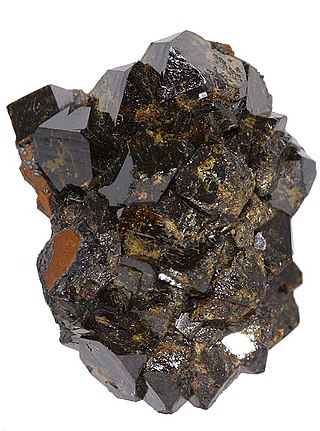
Beudandite is a secondary mineral occurring in the oxidized zones of polymetallic deposits. It is a lead, iron, arsenate, sulfate with endmember formula: PbFe3(OH)6SO4AsO4.

Sarkinite, synonymous with chondrarsenite and polyarsenite, is a mineral with formula Mn2(AsO4)(OH). The mineral is named for the Greek word σάρκιυος, meaning made of flesh, for its red color and greasy luster. The mineral was first noted in Sweden in 1865 as chondrarsenite, though not identified as sarkinite until 1885.
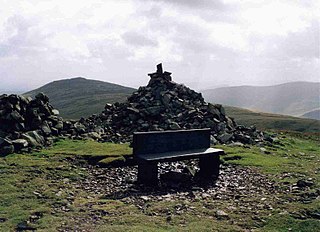
Ianbruceite is a rare hydrated zinc arsenate with the formula [Zn2(OH)(H2O)(AsO4)](H2O)2; material from the Driggith mine has traces of cobalt. It was first discovered at Tsumeb, approved by the International Mineralogical Association as a new mineral species in 2011, reference IMA2011-49, and named for Ian Bruce, who founded "Crystal Classics" in the early 1990s, and was heavily involved in attempts to reopen the famous Tsumeb mine for specimen mining.
In 2013 new occurrences of ianbruceite were reported from the neighbouring Driggith and Potts Gill mines on High Pike in the Caldbeck Fells, Cumbria, England. Here the mineral is probably a post-mining product. Caldbeck Fells and Tsumeb are the only reported localities for ianbruceite to date (May 2013).

Hidalgoite, PbAl3(AsO4)(SO4)(OH)4, is a rare member of the beudantite group and is usually classified as part of the alunite family. It was named after the place where it was first discovered, the Zimapán mining district, Hidalgo, Mexico. At Hidalgo where it was initially discovered, it was found as dense white masses in alternating dikes of quartz latite and quartz monzonite alongside other secondary minerals such as sphalerite, arsenopyrite, cerussite and trace amounts of angelsite and alamosite, it was then rediscovered at other locations such as Australia where it occurs on oxidized shear zones above greywacke shales especially on the anticline prospects of the area, and on fine grained quartz-spessartine rocks in Broken Hill, Australia. Hidalgoite specimens are usually associated with copper minerals, clay minerals, iron oxides and polymetallic sulfides in occurrence.

Köttigite is a rare hydrated zinc arsenate which was discovered in 1849 and named by James Dwight Dana in 1850 in honour of Otto Friedrich Köttig (1824–1892), a German chemist from Schneeberg, Saxony, who made the first chemical analysis of the mineral. It has the formula Zn3(AsO4)2·8H2O and it is a dimorph of metaköttigite, which means that the two minerals have the same formula, but a different structure: köttigite is monoclinic and metaköttigite is triclinic. There are several minerals with similar formulae but with other cations in place of the zinc. Iron forms parasymplesite Fe2+3(AsO4)2·8H2O; cobalt forms the distinctively coloured pinkish purple mineral erythrite Co3(AsO4)2·8H2O and nickel forms annabergite Ni3(AsO4)2·8H2O. Köttigite forms series with all three of these minerals and they are all members of the vivianite group.

Carminite (PbFe3+2(AsO4)2(OH)2) is an anhydrous arsenate mineral containing hydroxyl. It is a rare secondary mineral that is structurally related to palermoite (Li2SrAl4(PO4)4(OH)4). Sewardite (CaFe3+2(AsO4)2(OH)2) is an analogue of carminite, with calcium in sewardite in place of the lead in carminite. Mawbyite is a dimorph (same formula, different structure) of carminite; mawbyite is monoclinic and carminite is orthorhombic. It has a molar mass of 639.87 g. It was discovered in 1850 and named for the characteristic carmine colour.
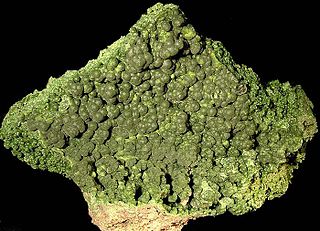
Mottramite is an orthorhombic anhydrous vanadate hydroxide mineral, PbCu(VO4)(OH), at the copper end of the descloizite subgroup. It was formerly called cuprodescloizite or psittacinite (this mineral characterized in 1868 by Frederick Augustus Genth). Duhamelite is a calcium- and bismuth-bearing variety of mottramite, typically with acicular habit.

Segnitite is a lead iron(III) arsenate mineral. Segnitite was first found in the Broken Hill ore deposit in Broken Hill, New South Wales, Australia. In 1991, segnitite was approved as a new mineral. Segnitite has since been found worldwide near similar locality types where rocks are rich in zinc and lead especially. it was named for Australian mineralogist, gemologist and petrologist Edgar Ralph Segnit. The mineral was named after E. R. Segnit due to his contributions to Australian mineralogy.

Arsendescloizite is a lead-zinc mineral, approved by the IMA in 1982. It is an arsenate analog of descloizite. Its first description was published in 1982.



















